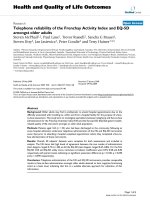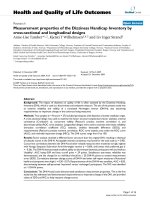báo cáo hóa học:" Long-term sequel of posterolateral rotatory instability of the elbow: a case report" ppt
Bạn đang xem bản rút gọn của tài liệu. Xem và tải ngay bản đầy đủ của tài liệu tại đây (2.5 MB, 5 trang )
CAS E REP O R T Open Access
Long-term sequel of posterolateral rotatory
instability of the elbow: a case report
Chun-Ying Cheng
*
Abstract
The natural course of untreated posterior lateral rotatory instability of the elbow is unclear. A case of elbow arthro-
sis with progressing deformity and flexion contracture after an episode of elbow dislocation about 20 years ago
presented the possibility the long term outcome of untreated posterior lateral rotatory instability of the elbow.
Introduction
The lateral collateral ligament complex of the elbow is
the main stabilized of posterolateral rotatory instability
and w as described by O ’Driscol l at 1991[1]. Poste rolat-
eral rotatory instability of the elbow results from insuffi-
ciency of the lateral ligamen tous and muscular support
of th e elbow, which allows the radial head and proximal
ulna to subluxate away from the humeral capitellum
and trochlea when axially loaded in supination [2]. The
long term outcome of unrecognized posterior lateral
rotatory instability of the elbow is unclear and rarely
reported. The author described a case of progressing
deformed elbow with flexion contracture after an epi-
sode of elbow dislocation about 20 years ago with the
symptom of tardy ulna nerve palsy for 4 months; the
ulnar nerve symptom and elbow function was improved
after a surgical repair of the lateral collatera l ligament
complex an d anterior transposition of the ulnar n erve.
This case of elbow arthrosis presented the possibility of
the nature course of posterior lateral rotatory instability
of the elbow.
Case presentation
A 46-year-old, right-hand-dominant male presented
with left ring and little fingers numbness and hand
weakness that had been aggravate d over the previous 4
mont hs. He had chronic pain and progressive deformity
of lateral elbow, and lost extension after on e episode of
elbow dislocation about 20 years ago. He was trans-
ferred to our office for further assessment with above
symptoms. Tracing back his trauma history revealed
that he noted a daily sensation of painful slip in and out
on the lateral elbow joint af ter a disloc ation underwent
a closed reduction by a bo nesetter. His elb ow symptom
didn’ t improve or got a diagnosis after visiting three
orthopedic surgeons for the first 6 months. Although
his elbow symptom was persisting but he was tolerable
at eating, dressing, carrying or pulling of daily activity or
working a bility except lifting or push-up and he didn’ t
visiting any physician for further help since then until
this new symptom of hand numbness occurred.
Physical examination revealed the elbow with flexion
arc from 20° to 120° and full forearm rotation compared
with contra lateral side, and grip strength 105 lb (1 25 lb
on the right side). Palpation revealed the deformed
elbow with prominent radial he ad not lateral epicondyle
on the lateral of the elbow. The result of neuro logic
examination was abnormal including paresthesias in the
ulnar half of ring finger and little finger and dorsal
ulnar wrist with positive Tinnel sign and nerve compres-
sion test of the ulnar nerve at elbow, li ttle finger abduc-
tion weakness but without claw hand deformity. Plain
radiographs showed arthrosis of the elbow joint with the
radiohumeral joint more sever than ulnohumeral joint,
radial head deformity including lost normal concave
shape and hy pertrophic margi nal osteophyte with lateral
subluxation and some chip bone or ectopic bone over
lateral epicondyle (Fig. 1). Patient was arranged to
receive operation with the surgical plan to decompress
theulnarnervebyanteriortranspositionofthenerve
and evaluate the elbow joint stability under anesthesia.
After general anesthesia, the lateral pivot shift test by
O’Driscoll’s method [1] with the patient’s arm overhead
was positive and the elbow stress test at fluoroscan
revealed negative valgus and varus stress test and
* Correspondence:
Department of Orthopaedic Surgery, Chang Gung Memorial Hospital, Chang
Gung University, Taoyuan, Taiwan
Cheng Journal of Orthopaedic Surgery and Research 2010, 5:5
/>© 2010 Cheng; licensee BioMed Central Ltd. This is an Open Access article distributed under the terms of the Creative Comm ons
Attribution Lic ense ( which permits unrestricted use, distribu tion, and reproduction in
any medium, provided the original work is properly cited.
positive lateral stress test [2], which the radiograph is
taken with provocative stress applied during the lateral
pivot shift test (Fig. 2). The operation was performed
with the patient positioned supinely and supported by a
hand table. The elbow was approached with two sepa-
rate lateral and medial incision. The traction neuropathy
of ulnar nerve at cubital tunnel was noted and intact
medial collateral ligament was identified after subcuta-
neously anterior transposition of the ulnar nerve. The
lateral structure was exposure through the Kocher inter-
val and an avulsed bone fragment of lateral collateral
ligam ent complex includin g common extensor from lat-
era l epicondyle was noted, the radial head was found to
translate posterior by provocative t est stress at 30° of
flexion and the annular ligament was found to be intact.
The lateral collateral ligament complex was repaired
with a bone anchor with No.2 polyester braided non-
absorbable suture, which in a running locked fashion at
origin of tendon and ligament [2] and augmented with a
bone screw to fix the avulsed fragment. Postoperatively,
the elbow was protected by a hinged brace with the
forearm in a neutral position for 4 to 6 weeks and the
flexion angle of the brace was allowed to step decreased
10° per week. Progressing loading and strengthening are
permitted for the late of 2 to 6 months.
At 24 months after surgery, the patient was satisfied
with the procedure; the symptom of ulnar nerve was
rec overing and he felt that his elbow was more comfor-
table and stable at daily activities except lifting. Exami-
nation revealed motion from 10° of extension to 130° of
flexion, 75° of pronation and 80° supination, and no
signs instability and grip strength increased to left 115
lb (126 lb on the right). Post-operative plain radiographs
showed the deformed radial head still subluxation at
anterior-posterior view but no progressing arthrosis of
the elbow joint(Fig. 3).
Figure 1 (A) Posteroan terio r (B) lateral radiographs of elbow showed degeneration of ul nohumeru s and radiohumerus joint with
radial head deformity and subluxcation and avulsed bone around the lateral epicondyle.
Cheng Journal of Orthopaedic Surgery and Research 2010, 5:5
/>Page 2 of 5
Discussion
Neglected or under-diagnosis the posterolateral rotatory
instability of the elbow is possible because plain radio-
graphs are commonly nondiagnosised. The symptoms of
this condition including pain, instability o r mechanical
snapping or popping are subtle and relevant. The clini-
cal assessment of subluxation and reduction sometimes
by provocative test is hampered by patient apprehension
and g uarding or only detected under anesthesia. Most
orthopedics surgeon didn’t understand the existence of
posterior lateral rotatory instability before the Dr.
O’Driscoll’s description at 1991 [1].
The patient presented the symptom and sign of loss of
extension, degenerative changes in the jo int, ectopic cal-
cification or neurological changes are common residual
sign and symptom following elbow dislocation [3,4].
Figure 2 Fluroscan of elbow without and with lateral stress (provocative stress applied) showed subluxed radial head posterior to the
midline of the capitellum.
Cheng Journal of Orthopaedic Surgery and Research 2010, 5:5
/>Page 3 of 5
The patient’ s symptom of radial head subluxation and
lost concave deformity of radial head without s ymptom
of forearm rotation and the sign of plain radiographs
showed arthrosis of the elbow joint w ith the radiohum-
eral joint more sever than ulnohumeral joint are differ-
ent from the consequence of simple elbow dislocatio n
or radial head dislocation. The diagnosis of posterolateal
rotatory instability in this case is undoubted because
there is positive lateral pivot shift test and lateral stress
test of fluoroscan under anesthesia and identified
avulsed fragment of lateral collateral ligament complex
during operation.
The cause of joint degeneration may be multiple fac-
tors, but the relation of joint instability and joint degen-
eration is interesting and deserving to be concern. The
relation of scapholunate ligament injury or scapholunate
dissociation (instability) in the wrist with scapholunate
advanced collapsed degeneration is well known; we need
more clinical studies of posterolatreal rotatory instability
of the elbow and biomechanical investigations of the
pivot-shift test of lateral collateral ligament complex to
establish this relationship and understanding the natural
course of posterolateral rotatoy istability of the elbow.
The radiographic findings of this case wit h elbow
arthrosismoreseversontheradiohumeraljointthan
ulnohumeral joint and the radial head hypertrophic
deformity and subluxation may be to characterize a
neglected ligament injury with rotatory instability.
Consent
Written informed consent was obtained from the patient
for publication of this case report and accompanying
images. A copy of the written consent is available for
review by the Editor-in-Chief of this journal.
Figure 3 (A)Posteroanterior (B) lateral radiographs of elbow 2 years after operation showed anchor suture and bone screw at lateral
epicondyle and incompletely reattached avulsed bone.
Cheng Journal of Orthopaedic Surgery and Research 2010, 5:5
/>Page 4 of 5
Competing interests
The author declares that they have no competing interests.
Received: 28 August 2009
Accepted: 27 January 2010 Published: 27 January 2010
References
1. O"Driscoll SW, Bell DF, Morrey BF: Posterolateral lateral rotatory instability
of the elbow. J Bone Joint Surg 1991, 73A:440-446.
2. Cohen MS: Lateral collateral ligament instability of the elbow. Hand Clin
2008, 24:69-77.
3. Josefsson PO, Johnell O, Gentz CF: Long-term sequela of simple
dislocation of the elbow. J Bone Joint Surg 1984, 66A:927-930.
4. Eygendaal D, Verdegaal SH, Obermann WR, VanVugt AB, Poll RG,
Rozing PM: Poterolateral dislocation of the elbow joint. Relationship to
medial instability. J Bone Joint Surg 2000, 82A:555-560.
doi:10.1186/1749-799X-5-5
Cite this article as: Cheng: Long-term sequel of posterolateral rotatory
instability of the elbow: a case report. Journal of Orthopaedic Surgery and
Research 2010 5:5.
Submit your next manuscript to BioMed Central
and take full advantage of:
• Convenient online submission
• Thorough peer review
• No space constraints or color figure charges
• Immediate publication on acceptance
• Inclusion in PubMed, CAS, Scopus and Google Scholar
• Research which is freely available for redistribution
Submit your manuscript at
www.biomedcentral.com/submit
Cheng Journal of Orthopaedic Surgery and Research 2010, 5:5
/>Page 5 of 5









